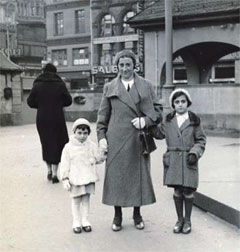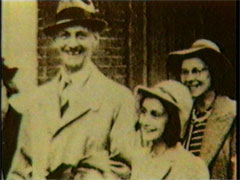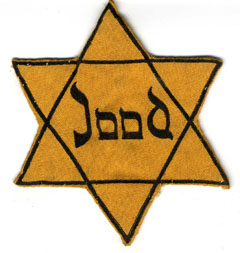
The Gies family visiting Otto Frank in Basel (Switzerland), summer of 1964.When Miep Gies (then still called Santruschitz) first met Otto Frank for the job interview at his Nederlandsche Opekta company in the late summer of 1933, they immediately took to each other. Otto Frank decided to hire Miep to replace a sick employee. When this Miss Heel reported back for work a few months later, Miep stayed on. She very much enjoyed her work at the office. Of course she did not discuss personal matters with her boss, but he had told her that his wife and two young daughters were still staying with his mother-in-law in Aachen, Germany. As soon as they found a house in Amsterdam to live in, the entire family would come over. Although he didn't express it, Miep sensed that he felt lonely without his family.
Whereas personal matters were discussed little at the office, world affairs all the more. As Miep remembers: ‘Mr. Frank and I quickly established a rapport as well, discovering our common passion for politics. We found ourselves on the same side of things. Although I had been brought up not to hate, I disapproved of the fanatic Adolf Hitler, who had recently seized power in Germany. Mr. Frank felt the same way, although much more personally, as he was Jewish. Mr. Frank had left Germany because of Hitler’s anti-Jewish policies.(...) Holding our little discussions in German, we agreed that it was just as well to turn one’s back on Hitler’s Germany and be secure and protected by our adopted homeland, Holland.'
Anne Frank (on the left) with her mother Edith and sister Margot wearing the white fur jacket, photographed by Otto Frank, March 1933 in Germany.By November 1933 the Frank family had found a house, in the same Amsterdam neighborhood where Miep lived with her foster parents. Edith Frank had come from Aachen a few times to search for a house, and once they had succeeded, the eldest daughter Margot joined them in December. By way of a birthday gift for Margot, Anne arrived in February 1934, then aged four. Shortly afterward Miep met Anne and her mother at the office. Otto Frank introduced his wife and daughter to her. Anne was wearing a white, fuzzy fur jacket and was shy and inquisitive at the same time. Miep brought coffee for the adults and a glass of milk for Anne. ‘Anne and I walked toward my desk. She looked with fascination at my shiny black typewriter. I held her little fingers to the keys and pressed. Her eyes flashed when the keys jumped up and printed black letters onto the invoice rolled into the machine. Then I directed her attention to the window – just the kind of lively scene I thought any child would like. I was right. The view caught her interest: the streetcars, the bicycles, the passersby. Watching Anne, I thought, Now, here’s the kind of child I’d like to have someday. Quiet, obedient, curious about everything.'
The apartment building at Amsterdam's Merwedeplein where the Frank family lived from 1933 to 1942.Miep started dating Jan Gies. During their lunch break, he often picked up Miep to go for a stroll. In that way he got to know Otto Frank as well. When Otto Frank one day invited Miep to come for dinner at their home, he added: “And bring Mr. Gies,” he added. I accepted, honored to be invited home by my boss to share a meal with his family.' As prescribed by etiquette, Miep and Jan rang the Frank doorbell promptly as six p.m. Otto Frank looked as well-groomed as at the office, but clearly a bit more laid-back. Mrs. Frank was just as friendly and as reserved as when Miep first met her. Edith Frank had not yet mastered Dutch very well, and since Jan was proficient in German, they continued to converse in German. They heard from Edith how she was still rather homesick for Germany, admired the antique furniture, made the acquaintance of the family cat, and discussed world events. When sitting down for dinner the two daughters Anne and Margot were called to join them, now eight and ten years old, respectively. After dinner, the girls disappeared into their room to do homework. Miep and Jan had another cup of coffee with Mr. and Mrs. Frank and continued their conversation. Again as prescribed by etiquette, after the second cup of coffee they thanked them for an enjoyable evening and left. This first dinner was the first of many to follow. Although these evenings kept their formal character, the personal stories that Edith shared with them allowed Jan and Miep to get to know the Franks better and better. The latest news was always a topic of conversation, but as soon as the children were called to the table the fearsome events taking place in the world were no longer discussed, and the adults switched instead to cheerful topics and stories. Anne would be the one doing most of the talking, Margot was much more reticent. Just as Miep and Jan, Anne loved the cinema and at the table they would discuss their favorite films and film stars in the minutest detail.
Besides for dinners, Miep and Jan were also invited for the Saturday afternoons with coffee and cake. On these afternoons the Frank family held open house, and Edith would present home-baked cheesecake or sponge cake. The other guests were all Germans, mainly Jewish refugees that had fled Nazi Germany, just like the Franks. Everyone was very politically aware, and the developments in Germany were discussed at great length, with everyone talking at the same time amidst clouds of tobacco smoke. ‘Although these people had not all known each other beforehand, they had much in common. Mr. Frank liked the idea of introducing these refugees to Dutch people who were interested in their lot, in why they had fled, and in their welfare here in Holland. Mr. Frank always introduced Jan Gies and me as “our Dutch friends”.’ Among these Saturday afternoon guests were Auguste and Hermann van Pels and Fritz Pfeffer. They would later be joining the Frank family in hiding in the Secret Annex.
Since Miep and Jan had no savings with which to furnish a house, to get married and to start their own life together, their dating phase continued for much longer than they would have wanted. There was also a severe housing shortage, due to the immense influx of refugees into Amsterdam. In 1939, when Miep had just turned thirty, they decided to nevertheless make work of finding a home and to then get married. It was Otto Frank who, shortly after the German invasion, pointed out an advertisement to Miep, offering rooms in their own neighborhood. The next day Mr. Frank accompanied Miep to see the rooms. The landlady was the Jewish Mrs. Stoppelman, and Miep decided to take the rooms. 
Otto and Anne Frank at the wedding of Miep and Jan Gies.After the initial panic and chaos that followed the German invasion and subsequent occupation, by the summer of 1940 life seemed to recover its daily routine. However, as fall set in, the first anti-Jewish measures were enforced. Though not too worrisome at first, the measures gradually become more oppressive. Miep and Jan grew increasingly worried for their Jewish friends, but they adapted and life carried on. On July 16, 1941, Miep and Jan were married with a small group of friends and family members in attendance. Mr. Frank had shut the office for the day so that Miep's colleagues could also attend. Otto Frank brought along his youngest daughter Anne, while Edith stayed at home to care for their sick daughter Margot. 'Anne’s eyes flicked nervously back and forth from Jan to me. She stayed close to her father, hanging on his hand. Perhaps we were the first romantic bride and groom she had ever seen in the flesh. I could see as she looked at Jan that she thought of him as a gallant, dashing figure. Perhaps she thought of me in the same way? A wedding was the number one romantic occasion for a girl of twelve.’
After the wedding ceremony, Otto Frank announced that he would be giving a party at and on behalf of the office, the next day. It was no use protesting, and Anne immediately called out that she would be there too. The next day the office was indeed transformed into a party room. ‘One of the travelling agents for the firm had brought liverwurst, sliced beef, salami, cheese, everything was laid out on plates. None of us had seen so much meat in a long time. “Too much food,” I told Mr. Frank. “Nonsense,” he said, smiling, so pleased to have something to celebrate in these grim times.’ As an accomplished waitress, Anne went from guest to guest with the dishes and on behalf of her family and the office personnel, she presented a silver plate to the newly-weds. 
Scraper from the NV Handelsvereeniging Gies & Co.The wedding provided a welcome two-day relief from reality: the anti-Jewish measures had now turned into a steady stream of restrictions and prohibitions. The open house afternoons at the Frank family were discontinued. Otto Frank asked Jan Gies if he would be willing to become commissioner of Pectacon, the spice trade, with Victor Kugler as executive director. Frank felt that his position in the company was starting to endanger everyone concerned, so he wished to withdraw. He would remain involved as adviser, and Johannes Kleiman would become managing director of the Nederlandsche Opekta company. The Pectacon firm would henceforth be called Gies & Co. On December 18, 1941 all the changes were authorized at a public notary's office. Jan was happy that he could help Otto Frank, and then with something as simple as with his surname.

Star of David that all Jews were obliged to wear. This one belonged to either Margot Frank or Mrs. Stoppelman, the landlady of Miep GiesFrom spring 1942, Jews were obliged to wear a yellow Star of David on their clothes. Not long after that, Otto Frank had a question for Miep. He told her that he and his wife had decided to go into hiding with the children, together with Hermann and Auguste van Pels and their son Peter, in the rear annex of the office premises on Prinsengracht. 'He took a breath and asked, “Miep, are you willing to take on the responsibility of taking care of us while we are in hiding?”
“Of course,” I answered. There is a look between two people once or twice in a lifetime that cannot be described by words. That look passed between us.’
What Miep's affirmative reply to Otto Frank's question entailed is described in another chapter on this website. Click here to see a video excerpt in which Miep Gies talks about the question that Otto Frank put to her.
All quotes in this chapter are taken from the book Anne Frank Remembered. The Story of the Woman Who Helped to Hide the Frank Family. By Miep Gies with Alison Gold. Simon and Schuster, New York 1987. A new edition of the book is expected for early 2009.


